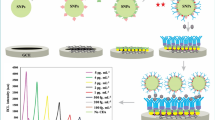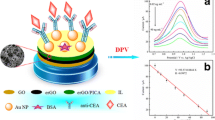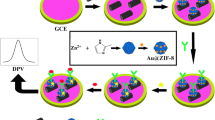Abstract
In this study, due to the oxidative and strong adhesion characteristics of mussel-inspired polydopamine, the aimed antibody-anti-CEA could be directly attached to the polydopamine-coated glassy carbon electrode surface. The immobilization method and sandwich immunoreactions strategy were applied to form a facile and effective electrochemical immunosensor. Anti-CEA was verified by attenuated total reflection Fourier-transform infrared spectroscopy (ATR-FTIR), X-ray photoelectron spectroscopy (XPS), and atomic force microscopy (AFM). Under optimum conditions, a linear response range of CEA from 0.01 to 80 ng/mL with a low detection limit of 1.58 pg/mL was obtained by the differential pulse voltammetry determination. Assay results of clinical serum samples using the standard ELISA and reference methods gave an excellent correlation and dependence. Moreover, the preparation of immunosensor with low cost, convenient operation, and all steps processing at room temperature which possesses great potentials for practical applications.









Similar content being viewed by others
References
Lee H, Dellatore SM, Miller WM, Messersmith PB (2007) Mussel-inspired surface chemistry for multifunctional coatings. Science 318:426–430
Lee H, Rho J, Messersmith PB (2009) Facile conjugation of biomolecules onto surfaces via mussel adhesive protein inspired coatings. Adv Mater 21:431–434
Hong S, Na YS, Choi S, Song IT, Kim WY, Lee H (2012) Non-covalent self-assembly and covalent polymerization co-contribute to polydopamine formation. Adv Funct Mater 22:4711–4717
Zhang Z, Zhang Z, Li J, Lai Y (2015) Polydopamine-coated separator for high-performance lithium-sulfur batteries. J Solid State Electrohem 19:1709–1715
Shahbakhsh M, Noroozifar M (2018) Copper polydopamine complex/multiwalled carbon nanotubes as novel modifier for simultaneous electrochemical determination of ascorbic acid, dopamine, acetaminophen, nitrite and xanthine. J Solid State Electrochem 22:3049–3057
Lai GS, Wu J, Ju HX, Yan F (2011) Streptavidin-functionalized silver-nanoparticle-enriched carbon nanotube tag for ultrasensitive multiplexed detection of tumor markers. Adv Funct Mater 21:2938–2943
Resende LO, Castro ACH, Andrade AO, Madurro JM, Brito-Madurro AG (2018) Immunosensor for electrodetection of the C-reactive protein in serum. J Solid State Electrochem 22:1365–1372
Lim SY, Shen W, Gao ZQ (2015) Carbon quantum dots and their applications. Chem Soc Rev 44:362–381
Yang H, Li Y, Liu Y, Zhang Y, Zhao Y, Zhao M (2015) One-pot chemical blasting synthesis of the bamboo-like multiwalled carbon nanotubes/graphene oxide nanocomposite and its application in electrochemical detection of dopamine. J Solid State Electrochem 19:145–152
Santhosh C, Velmurugan V, Jacob G, Jeong SK, Grace AN, Bhatnagar A (2016) Role of nanomaterials in water treatment applications: a review. Chem Eng J 306:1116–1137
Punetha VD, Rana S, Yoo HJ, Chaurasia A, McLeskeyJr JT, Ramasamy MS, Sahoo NG, Cho JW (2017) Functionalization of carbon nanomaterials for advanced polymer nanocomposites: a comparison study between CNT and graphene. Prog Polym Sci 67:1–47
Qu Y, Chen L, Deng H, Li C (2017) Sandwich-type electrochemical immunosensor for sensitive determination of IgG based on the enhanced effects of poly-L-lysine functionalized reduced graphene oxide nanosheets and gold nanoparticles. J Solid State Electrochem 21:3281–3287
Kharisov BI, Dias HVR, Kharissova OV, Vázquez A, Peñaa Y, Gómeza I (2014) Solubilization, dispersion and stabilization of magnetic nanoparticles in water and non-aqueous solvents: recent trends. RSC Adv 4:45354–45381
Lee H, Shin TH, Cheon J, Weisslede R (2015) Recent developments in magnetic diagnostic systems. Chem Rev 115:10690–10724
Ramimoghadam D, Bagheri S, Hamid SBA (2015) Stable monodisperse nanomagnetic colloidal suspensions: an overview. Colloids Surfaces B 133:388–411
Li M, Liu X, Xu Z, Yeung KWK, Wu S (2016) Dopamine modified organic−inorganic hybrid coating for antimicrobial and osteogenesis. ACS Appl Mater Interfaces 8:33972–33981
Zhang Y, Pan D, Zhou Q, Zhao J, Pan N, Zhang Y, Wang L, Shen Y (2018) An enzyme cascade-based electrochemical immunoassay using a polydopamine-carbon nanotube nanocomposite for signal amplification. J Mater Chem B 6:8180–8187
Xue H, Zhao J, Zhou Q, Pan D, Zhang Y, Zhang Y, Shen Y (2019) Boosting the sensitivity of a photoelectrochemical immunoassay by using SiO2@polydopamine core-shell nanoparticles as a highly efficient quencher. ACS Appl Nano Mater 2:1579–1588
Wang XB, Zhou M, Zhu YY, Miao JJ, Mao C, Shen J (2013) Preparation of a novel immunosensor for tumor biomarker detection based on ATRP technique. J Mater Chem B 1:2132–2138
Liu QZ, Yu B, Ye WC, Zhou F (2011) Highly selective uptake and release of charged molecules by pH-responsive. Macromol Biosci 11(9):1227–1234
Dreyer DR, Miller DJ, Freeman BD, Paul DR, Bielawski CW (2012) Elucidating the structure of poly(dopamine). Langmuir 28(15):6428–6435
Li Y, Zhang Y, Li F, Feng J, Li M, Chen L, Dong Y (2017) Ultrasensitive electrochemical immunosensor for quantitative detection of SCCA using Co3O4@CeO2-Au@Pt nanocomposite as enzyme-mimetic labels. Biosens Bioelectron 92:33–39
Barman SC, Hossain MF, Yoon H, Park JY (2018) Trimetallic Pd@Au@Pt nanocomposites platform on -COOH terminated reduced graphene oxide for highly sensitive CEA and PSA biomarkers detection. Biosens Bioelectron 100:16–22
Li Y, Chen Y, Deng DM, Luo LQ, He HB, Wang ZX (2017) Water-dispersible graphene/amphiphilic pyrene derivative nanocomposite: high AuNPs loading capacity for CEA electrochemical immunosensing. Sensors Actuators B Chem 248:966–972
Wang H, Wang YG, Zhang Y, Wang Q, Ren X, Wu D, Wei Q (2016) Photoelectrochemical immunosensor for detection of carcinoembryonic antigen based on 2D TiO2 nanosheets and carboxylated graphitic carbon nitride. Sci Rep 6:27385–27392
Song YH, Shen Y, Chen JY, Song YG, Gong CC, Wang L (2016) A pH-dependent electrochemical immunosensor based on integrated macroporous carbon electrode for assay of carcinoembryonic antigen. Electrochim Acta 211:297–304
Funding
The work was supported by the National Natural Science Foundation of China (21604022, 21502051), the Scientific Research Fund of Hunan Provincial Education Department (15B159), the Natural Science Foundation of Hunan Province (2016JJ3097, 2018JJ3370), and the Huxiang Youth Talent Support Program (2018RS3147).
Author information
Authors and Affiliations
Corresponding author
Ethics declarations
All procedures performed in this study involving human participants were approved by The Second Xiangya Hospital, Central South University, and were in accordance with the ethical standards of Xiangya Hospital ethics committees China.
Additional information
Publisher’s note
Springer Nature remains neutral with regard to jurisdictional claims in published maps and institutional affiliations.
Rights and permissions
About this article
Cite this article
Wang, X., Hu, X., Xiao, F. et al. A convenient signal amplification strategy for the carcinoembryonic antigen determination based on the self-polymerization of dopamine. J Solid State Electrochem 23, 2447–2453 (2019). https://doi.org/10.1007/s10008-019-04325-2
Received:
Revised:
Accepted:
Published:
Issue Date:
DOI: https://doi.org/10.1007/s10008-019-04325-2




